By Tommy Clarkson from the April 2016 Edition
Silver Fittonia, Fittonia argyroneura
Family: Acanthaceae
Also known as Fittonia, Nerve Plant, Silver-Net Plant, Silver Fittonia, Fittonia Net Leaf, Silver Nerve, Silver 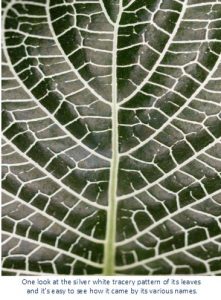 Threads, Painted Net Leaf, Mosaic Plant, Lace leaf, Snakeskin Plant or Silver Net Leaf ‘White Brocade’.
Threads, Painted Net Leaf, Mosaic Plant, Lace leaf, Snakeskin Plant or Silver Net Leaf ‘White Brocade’.
(While doing secondary research, somewhere along my ongoing tropical plant trek, I came across an article with supporting pictures wherein this was called Window Pane Plant. I was elated as theretofore, I didn’t know its name. This piece described how a variety of geometrical forms could be found in the vein structure of these plants. As a result of this, ever since, I have called it such when giving tours of Ola Brisa Gardens. Upon deciding to write about it lo and behold I find that this name may be incorrect. To these folks I apologize at my, possibly, imparting, incorrect data. . . . but then again, I’ve never made claims of being anywhere near the upper reaches of wizened, botanical academic knowledge!)
So noted, I have since discerned that this attractive, stem rooting, ground cover plant is one of species of creeping, perennial herbs from South America. (It’s a ground hugger!) One has simply so see it to recognize that its natural environment, quite logically, is the moist rainforest understory. Given these native environs, it follows that it prefers a high humidity environment and – dependent upon where it is to be grown – misting may be necessary to maintain its naturally preferred humidlike conditions.
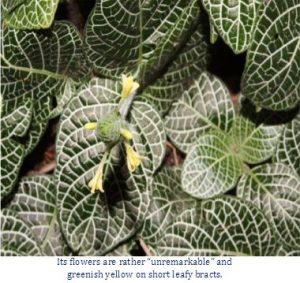 While the leaves of this plant and species kin have a silver white tracery pattern, the F. Verschaffeltii has veins of red. F. pearcei is a carmine pink-veined beauty. All are short-stalked, elliptically shaped and heavily veined. It may be as short as six inches (15.24 cm) or fully stretching as tall as it can reach twelve (30.48 cm) in height. Riffle, correctly observes that what with their (up to) four inch (10.16 cm) long “dark green (leaves) with a network of white or scarlet. . . (it) is difficult to imagine a more beautiful low groundcover.”
While the leaves of this plant and species kin have a silver white tracery pattern, the F. Verschaffeltii has veins of red. F. pearcei is a carmine pink-veined beauty. All are short-stalked, elliptically shaped and heavily veined. It may be as short as six inches (15.24 cm) or fully stretching as tall as it can reach twelve (30.48 cm) in height. Riffle, correctly observes that what with their (up to) four inch (10.16 cm) long “dark green (leaves) with a network of white or scarlet. . . (it) is difficult to imagine a more beautiful low groundcover.”
Conversely, its flowers are rather “unremarkable” and greenish yellow on short leafy bracts. Being rather inconsequential, they tend to meld into the remainder of the foliage.
The Silver Fittonia requires regular water moist, but never soggy well draining, humusy soil, and does not like direct sun, preferring partial to full shade. If it gets too much hot sun, even indoors, the leaves may turn brown and burn.
None of these species care one tiny bit for the cool and should one’s evening get so, we encourage that they be pot planted so it can be taken indoors during the chill of the night. Accordingly it should come as no surprise that many folks use the Fittonia argyroneura hanging baskets, dish garden or terrariums.
Given the year around temperatures here on the central Pacific coast of Mexico, ours grow in a small bed 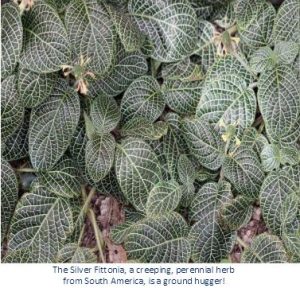 on the Casita Terrace, beneath – delightfully complementary in appearance – Climbing Fig that are scaling the wall directly behind their terra firma home.
on the Casita Terrace, beneath – delightfully complementary in appearance – Climbing Fig that are scaling the wall directly behind their terra firma home.
Propagation can be attained through rooted stem pieces or tip cuttings of three to four pairs of leaves, making sure to include at least two growing nodes. Note: use of a root hormone might enhance your chances of success.
Because it is, by nature, a trailing plant, the Silver Fittonia can take on a straggly appearance. Simply, prune the tips to create a bushier plant. If grown in a pot, repot annually.
It has few natural enemies. However, carefully avoid overwatering as this can lead to root rot. Beyond that, Xanthomonas leaf spot, which causes vein necropsy and mosaic virus can be problems. Legged pests include fungus gnats, aphids, mealybugs and thrips.
As to general parental oversight on your “plant child”, yellowed, wilting leaves are a sign of overwatering. Shriveled leaves indicate that the air is too dry or in too much light. Whereas, a collapsed plant signals it isn’t had enough to drink but if it hasn’t been too dry, for more than a few hours will generally will perk back up with watering.
I’ve come across one reference to a F. gigantea which has purple stems with dark green leaves and crimson veins and, which supposedly can (I’m assuming heightwise) reach 24 inches (60.96 cm) the article does not elaborate.
As to how it came about its primary name the Fittonia plant is named for Irish sisters Elizabeth and Sarah Fitton, who, in 1817, wrote Conversations on Botany.
For back issues of “Roots”, gardening tips, tropical plant book reviews and videos of numerous, highly unique eco/ adventure/ nature tours, as well as memorable “Ultimate Experiences” such as Tropical Garden Brunches
visit us at… www.olabrisagardens.com
Download the full edition or view it online
—
Tommy Clarkson is a bit of a renaissance man. He’s lived and worked in locales as disparate as the 1.2 square mile island of Kwajalein to war-torn Iraq, from aboard he and Patty’s boat berthed out of Sea Bright, NJ to Thailand, Germany, Hawaii and Viet Nam; He’s taught classes and courses on creative writing and mass communications from the elementary grades to graduate level; He’s spoken to a wide array of meetings, conferences and assemblages on topics as varied as Buddhism, strategic marketing and tropical plants; In the latter category he and Patty’s recently book, “The Civilized Jungle” – written for the lay gardener – has been heralded as “the best tropical plant book in the last ten years”; And, according to Trip Advisor, their spectacular tropical creation – Ola Brisa Gardens – is the “Number One Tour destination in Manzanillo”.



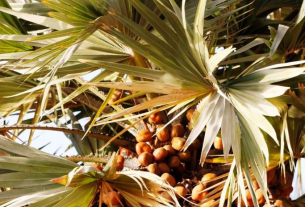
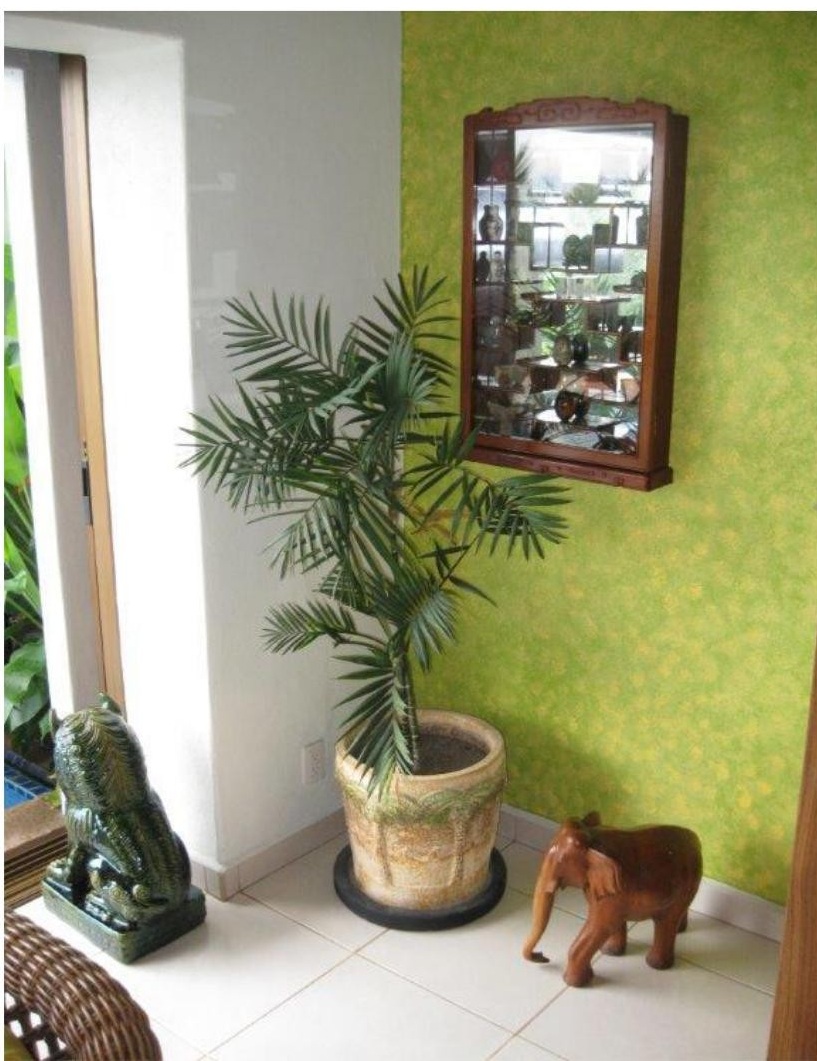
You must be logged in to post a comment.